
Light Novels: ReviewsTitle: Durarara v01 Narita is an interesting author. He started out with Baccano in 2003, a series which has piled up as many as 14 volumes, and had a much loved anime in 2007. In the meantime he’s also managed to write 5 volumes of Vamp, another 5 volumes of the Etsusa Oohashi series, 3 volumes of Hariyama-san, and finally 7 volumes of Durarara, which is currently being adapted into an anime. The illustration is handled by Yasuda Suzuhito, who’s also drawing his very own manga, Yozakura Quartet. Unlike most light novel series, Narita has a tendency to focus not so much on a specific protagonist and plot, but rather the development of a subculture with a large cast of interesting characters. The narrative will jump between these people, simultaneously telling separate stories, which at first seem completely unrelated and confusing. Gradually you see glimpses of what direction they’re heading, and tension will grow as all threads finally collide into one huge moment of utter holy shit epicness, when everything suddenly clicks. The first volume mostly handles things from the point of view of Ryuugamine Mikado, a youngster who’s just moved to Ikebukuro in Tokyo to enter high school, after years of being spurred on by his childhood friend Kida Masaomi’s extravagant chat reports of adventures there. In alternating chapters, we’re also introduced to a mute apparition in the form of a headless rider by the name of Celty, who smuggled herself into Japan on a quest to find her stolen head and the lost memories within. The whereabouts of this non-vital bodypart, along with the machinations of a mysterious organization called the “Dollars”, are what fill the majority of the pages, but we also run into some ten other memorable characters before it finally wraps things up. With some solidly written and charming dialogue, Narita succeeds in creating a great gallery of individuals, who in all their unique quirks combine to form a living, breathing world. The problem is that the prose between conversations is sub-par, with the depiction of events often feeling like it’s scribbled down by a bored blogger summarizing anime episodes, completely void of flair and finesse. In spite of the writing, Durarara remains an excellent read, since after all the pages of build-up, the pay-off is just so fantastic that flipping the pages left me with a huge grin on my face that refused to fade. Amazon link: Japanese
Title: Durarara v02 Going into the second volume, I told myself there was no way he could top the amazing finale of the previous book, but oh how very wrong I was. It somehow got even better. The spotlight turns to shy Sonohara Anri, Mikado’s bespectacled classmate, whose ample chest gets her into trouble with a lewd teacher. While Masaomi saves her temporarily, she decides to seek out a girl rumoured to have been involved with the teacher, but who suddenly switched schools in the middle of the term. In other parts of town, a reporter is trying to figure out who is strongest in Ikebukuro, a trail which leads to Heiwajima Shizuo, the man with a dozen bartender suits. And in the dark, a vicious slasher is attacking people seemingly at random, with shining red eyes and a bladed weapon. A mix of action comedy, detective work and supernatural thriller, boosted by better pacing with the early appearance of Saika, I have to rate Durarara v02 even higher than the original novel. Some of the setting seems to have changed between books, but it serves to build stronger supporting characters, so I don’t really mind. The only worry is that the series will start to show signs of power inflation. Amazon link: Japanese
Title: Durarara v03 As you can see in the line above, this volume was a hundred pages thicker than the earlier installments, and it’s not a good thing. It is Kida Masaomi’s turn to be protagonist (if you can call it that; the true main character is probably Celty, who gets a decent amount of exposure in all three novels), and his battle with the past. This leads to a ton of flashbacks meant to flesh out his character, and at the same time sheds some light on the mischievous information broker Orihara Izaya. We also get more details about the otaku van gang lead by Kadota, as the emerging colour gang “Yellow Turbans” make their presence felt. It should be interesting and exciting and whatnot, but in the end it feels like all build-up and no proper climax. Unlike the previous books, it’s a slow jog all the way through, and never really lifts off the ground, despite some nice flashes here and there. Finishing Durarara v03 left me burnt out on the series, and I’ll be taking a break from Narita for a while. If anyone’s wondering, the anime seems to be running the stories of all three volumes simultaneously, sometimes adding completely anime-original characters and events, which makes for a fairly fresh view despite knowing what will happen. Amazon link: Japanese
Title: Sugar Dark v01 Heralded as the Next Big Thing, destined to change light novels forever, Sugar Dark rode the waves of being the first title to win the Sneaker Grand Prize since Haruhi way back in 2003. I ordered it instantly, of course. Written and rewritten by Arai Enji, who couldn’t shake the feeling that he could create something brilliant with the theme of grave diggers, the resulting novel is set in an alternate universe, where humanity has been struggling against The Dark, an evil that takes the shape of huge monsters that seemingly stepped right out of your nightmares. This force of annihilation has kept humanity’s progress shackled, until one day when someone discovered that the immortal creatures could be stopped, if buried in human cemeteries. One of these places sees the arrival of our main character, Prisoner 5722, a young man of 16 years and formerly in the military, who has been stripped of his name, wrongfully accused of murdering his superior officer, and is now condemned to work as a gravedigger. Struck by the graveyard’s eerie atmosphere, his suspicions grow as he’s ordered to dig enormous holes. One night he runs into a beautiful girl, introducing herself as Meria, the grave keeper. Intrigued by her nocturnal appearances, and aided by an enigmatic boy who tells him of these hidden battles, our hero chooses to wade deeper into the dark. While giving off a dark and fascinating aura with the setting, Sugar Dark buries itself in a terribly slow pace, with long descriptions and similes in ambitions of reaching literary heights. An entire page was spent on telling the reader how the main character walks up to a tree. Some people no doubt find this poetic and delightful, but I quickly get bored to death as nothing ever happens. The book could easily have been 50 pages shorter if they’d attached an editor who cared. God only knows why they gave it an award. An even bigger problem than the pacing is how bloody juvenile it is. I was 16 once, so I know what it’s like to have your mind stuffed with cute girls and fluffy bunnies, but it doesn’t make it worth reading about as an adult. Repeatedly hitting us over the head with how beautiful a girl is doesn’t make her a good character, and Meria generally comes off as a retarded moe kitten more than a romantic interest. Moreover, the antagonists and conflicts fail on an emotional level. It’s impossible to feel engaged when the enemy is simply labelled “evil” and described as “scary”. They may as well be fighting shadows, because these faceless monsters are as solid as mist to the reader. Personally I crave a reason that drives the opposition, so I can understand their side of the conflict, giving it substance. With all that hype it was probably inevitable, but I was left disappointed. Amazon link: Japanese
Title: MAMA Kougyoku’s debut work Mimizuku to Yoru no Ou had me enchanted and hungry for more, so I was happy to dig into her next novel, MAMA, which seems to take place in the same world, but is otherwise unrelated in story. Once again the theme is about man-eating demons, but not necessarily evil ones. Born into the prestigious Salvador clan, famed for its line of great magicians, little Toto is seen as a failure. She doesn’t have much of a talent for magic. Bullied by the other children, she hides from their jeers, and comes to overhear teachers discussing how she might be better off adopted away, so as not to sully their reputation. Understandably upset, she rushes to the comfort of the library, but trying to stay out of sight of the adults, she unwittingly opens the door that seals a legendary demon in the form of a little boy her own age. In order to fight off her crushing solitude, she decides to become his… mother. I’d been wondering if the true style of Kougyoku was the mesmerizing inventiveness of the first half of Mimizuku, or the less interesting second half, and with this novel I think it’s safe to say that she usually writes the dull kind. The setting and atmosphere are charming enough, bringing to mind Neil Gaiman, but the characters are rather flat, and the prose is overly simple and repetitive. I wouldn’t go as far as to say it’s bad, but after her previous novel, I hoped for so much more. Amazon link: Japanese
Title: Satougashi no Dangan wa Uchinukenai Having finished A Lollypop or a Bullet, as it’s also called, the thought filling my mind was: What the FUCK? That was written by the same person as GOSICKs? How? What? Huh? A strange read, really. I find it absurd that they originally published it with illustrations, and no doubt it’s better off in the current format, clean and naked. Reading up on it on Wikipedia I also noticed there’s a goddamn manga of it, which seems ridiculous. If ever there was a light novel that wasn’t a light novel, surely this is it. It’s anything but light. How do you get out of that story without a heavy heart? It opens with a newspaper article explaining that the chopped up body of 13-year-old Umino Mokuzu had been found in the hills, gripping me instantly. The story then follows her classmate, from the day of Mokuzu’s arrival as a transfer student and her peculiar introduction, then through subsequent events as the two grow closer. And simultaneously, the unravelling of Mokuzu’s background. It’s tragic and depressing and it just goes on and on. I kept thinking there would be a twist eventually, that the girl was really a mermaid as she claimed, that there would be a happy end somehow, but suddenly I ran out of pages, and she was still dead. Where’s the “light” in that? No wonder Sakuraba went on to write regular novels. Lollypop and Gosick are miles apart, and the former is clearly superior. If the book that won the Naoki prize is even better, I’m going to have to get a hold of it some day. Feels like I owe her that. I spent the rest of the week gloomy, though. Amazon link: Japanese
Title: Oishii Koohii no Irekata v01 While I didn’t know it back when I first ordered this title, it’s actually written by a woman who won the Naoki Prize for Hoshiboshi no Fune in 2003, just like Sakuraba Kazuki above. It was surprising to me, mostly because this first part of the now 13 books long Oishii Koohii series wasn’t particularly good. It’s pleasant enough as romantic stories go, with high schooler Izumi Katsutoshi abruptly finding himself living with his two cousins, as the parents in both families move out of town, and figure it’s convenient to have the youngsters under the same roof, looking after each other. Katsutoshi starts out furiously opposing this idea, since he’s been taking care of himself since the death of his mother years ago, but gradually changes his mind as he discovers what a radiant beauty his older cousin Karen has become. Observing Katsutoshi as he tackles his feelings is somewhat amusing, but the way things turn out is laughably convenient. Even then, the biggest problem lies in the fact that in spite of being written as the first person narrative of a male character, it is utterly impossible to shake the knowledge that the author was female. I’ve never known a man who’d care so much about the details of someone’s clothing, and all the mannerisms added to make the protagonist act manly simply feel contrived and silly. Still, parts of the book manage to charm, and after the shocking transformation I saw from Sakuraba, I was willing to give Murayama the benefit of doubt, and her award winning title now graces my bookshelf for future perusal. Amazon link: Japanese
Title: To Aru Majutsu no Index v01 Everyone must know this title intimately by now, what with the anime in 2008 and its spin-off Railgun still running. If by some odd chance you’ve been hiding in the closet, all you need to know is that it’s a mixed sci-fi and fantasy series about a high school guy called Kamijou Touma, who wields a fist with the power of nullification, and lives a hectic life in a special city built for the education and research of kids with different abilities, varying in levels from 0 to 5. Kamijou, whose power seems to defy all the tests designed to determine the potency of an ability, obviously gets labelled as a 0. But fear not, my friends, for a cute girl soon falls into his life (quite literally), opening his eyes to the existence of magic, which works as a kind of opposite to the “scientific” abilities, related more closely to religion and myth. This brings with it an extreme amount of jargon, and wading through it can only be compared to Shakugan no Shana. Luckily Index manages to be a lot more fun and exciting, with some decent jokes, action pieces, and cute characters — especially the adorable Misaka Mikoto, a fierce tsundere who discharges electricity at will. Amazon link: Japanese
Title: To Aru Majutsu no Index v02 …which of course turned out to be a massive disappointment. It wasn’t a bad book, the second half. Once they stopped babbling about the hundreds of years of important history and important details used to build the story into something more … intellectually rewarding? I don’t know. It didn’t do a thing for me, at least. I was more amused by Index-tan showing some jealousy, but maybe I’m a romantic teenage girl at heart, rather than a hard-boiled sci-fi nerd burning for techno babble. I estimated that as much as 90% of the first 120 pages were given to endless explanations, often repeated twice over. To make a James Bond comparison, instead of enjoying the anticipated bang-bang and womanising, you only get a comprehensive two-hour tour of the villain’s lair. Without the sharks. The experience left me sick to death of the series, and I’ve put it on hold indefinitely, while I work through the rest of my library. Amazon link: Japanese
Title: Kieli v01 Encouraged by the information that Kieli was both a finished series at 9 volumes, and that it had won the Dengeki Novel Prize (beating out Baccano), I picked up the first two parts, and eventually even got around to reading this first book. It quickly sets up an interesting atmosphere on a settled world in the distant future, where war has wasted most of the natural resources, and technology has started to regress, leaving society in decline. The protagonist is a 14-year-old orphan girl who happens to see ghosts, including her talkative dorm roommate. One day she runs into Harvey, a young man who, just like her, sees the spirits of the dead. Except in his case, it’s because his heart has been replaced by a now mythical power source that has rendered him immortal, a practice used in the war to build super soldiers. With the war finally over, the members of this legion suddenly found themselves hunted down and destroyed, their existence no longer deemed useful by the governing church. Attracted by the bond they share with the realm of the deceased, Kiiri joins him on his journey to put to rest the soul of an old friend who dwells in a radio, meeting new ghosts along the way, and helping them come to terms with their situation. Summarized like that it probably sounds alright, but the author’s style is a clear example of thesaurus abuse and not knowing when to stop. The writing is filled to the brim with excessive detail, describing every little thing right down to which step on the staircase someone’s foot has reached. It makes for a tedious read, and much like Murayama a few entries up, Kabei Yuka is unable to write convincing male characters, where she attempts to emulate the way a man would behave, without capturing the essence. This was the second time in a short while that I’d been struck by flawed cross-gender writing, but it’s normally not something I think about. In the multitudes of novels by female authors I’ve read before, the male depiction has never bothered me, but here it sticks out like a sore thumb. I can’t even imagine what it must be like for girls to read novels written by insensitive men. Amazon link: Japanese
Importing books is expensive, so in order to keep shipping costs down I always try to buy at least ten books at a time. However, finding ten interesting titles can be a difficult task, and sometimes I end up throwing dubious novels on the pile just to pad the numbers. One of these was Aru Hi, Bakudan ga Ochitekite, a name I only vaguely remembered having seen somewhere, but its meaning — One day, a bomb came falling down — got my imagination going, pondering what kind of missile it could be, and how the victims of this explosion would be affected. It was nothing like I imagined. Furuhashi Hideyuki is somewhat of a veteran, having published his first novel Black Rod back in 1996, which won him the Dengeki Novel Prize. He’s followed it up with more than a dozen works (including Demonbane novelizations), but there seemingly hasn’t been much published after 2007. The illustrations were made by Higa Yukari, a woman whose work on the Lyrical Nanoha Force manga may be familiar to many. She’s also drawing some sort of manga version of Kiddy Girl-and, the upcoming sequel to Kiddy Grade. Personally I find the illustrations in this novel to be a bit wonky, but if the images on her website are anything to go by, she’s improved since then. I started reading Aru Hi… like any old novel, but was stumped when after 50 pages, a new chapter appeared with an entirely new main character — despite being a first person narrative. That’s when I realized it wasn’t a full length novel, but rather a collection of short stories. Unlike the recently reviewed GOSICKs, where the short stories were about the same characters living through new events, the short stories in Aru Hi… all have completely different characters and settings, but these are bound together by a common theme: time. Ended time, reversed time, looped time, time length, swapped time, time difference, and time jump.
The short story is a fascinating format. There are authors who spend dozens upon dozens of volumes trying to tell their stories (Zero no Tsukaima comes to mind), describing every minor event and filling thousands of pages. Yet this book contains examples of stories told in under 50 pages, which have just as much emotional impact. And depth, because whereas recounting everything in utmost detail leaves nothing for the reader to imagine, the big, rough strokes of a short story will create gaps that your own imagination can fill, increasing its reach far beyond what is written. These short stories are like snowballs; an idea that rolls around in your mind, picking up thoughts and emotions, growing until it comes tumbling down like an avalanche. Furuhashi’s words guide you, but as a reader you take part in the tale’s conception. Aru Hi… closes with a thought-provoking story of a young woman who stands in the middle of a park, frozen in time like a monument to a war many years earlier. She was at the focal point of a spatiotemporal tidal bomb’s detonation, which wiped out the entire city around her, but her position in this perfect eye of the storm left her stuck in a bubble where time has slowed down to 1/6000000000th. While life outside the bubble has moved on 60 years with the city rebuilt, to her no more than 0.3 seconds have passed, as the seasons flicker past before she’s even managed to blink. Intrigued by this “girl in amber” is our narrator — a boy whose thoughts and choices end up touching us, but along the way we’re also gifted with an opportunity to fantasize about what it must be like to see civilizations flash away one after another, unable to move and all alone. Amazon link: Japanese
What constitutes a light novel? It’s a question you have to ask yourself when reading Mimizuku to Yoru no Ou, because there’s no hint of manga style on the cover, and the inside of the book has no illustrations at all. It is, however, published by a light novel label, and Wikipedia has it classified as such, so who am I to argue? Either way, the novel is a wonderful literary work, light or not. This is the author’s first book, with two more released over the years since its release, despite the fact that she’s still only in her mid-twenties. She’s also dabbled in scenario writing, contributing to titles like Hikari no 4 Senshi: Final Fantasy Gaiden, which is to be released later this year. Maybe it’s finally time to buy one of those Nintendo DS gizmos. Mimizuku to Yoru no Ou is the story of an insane little girl in chains who wanders into the Forest of Night, with the intention to meet the King of Night — the ruler of demons — and persuade him to eat her. The book is beautifully written, with crisp and concise sentences that sweep you away to its magical world instantly. It tastes distinctly of fairy-tale, but dark and mysterious, much like Neil Gaiman’s work. It’s kept simple, yet elegant. The way Kougyoku uses commas and periods to shape the flow of words works incredibly well to convey the notion that the main character is quite mad, further enhanced by drawing out the final syllable in each of her spoken lines. It creates an eerie mood, which is utterly bewitching and otherworldly. I do wonder how it could be reproduced in a language like English, though. It’s hard to imagine reading an extended “you” without being irritated rather than charmed. I wish I could end the entry with nothing but praise, but the story changes midway through, with a move into a different atmosphere altogether, and the consequence is a loss of much of what I found so captivating initially. That isn’t to say it goes bad, but the fascinating magic feeling is taken away, and the plot resolution that follows is overly nice and quaint. And, perhaps, too predictable. It remains a lovely read with an adorable heroine, but I saw potential for something glorious in that first half of the novel. Amazon link: Japanese
If there’s a “Dumbest Title” award, this one has a great shot at taking home the prize. It’s probably a pun on “gothic”, but as a Westerner, it just feels wrong to me. Go sick? What? At least this particular volume’s wacky name is mellowed by the poor little ’s’ that follows it, indicating that it’s not a part of the series proper, but rather a collection of short stories that take place here and there on the time line. The GOSICK series itself started with a standard length light novel back in 2003, and this first volume of the short story collections showed up in 2005, after the 4th regular novel had already been released. The reason I’m reading this one first is that the short story that starts it off is chronologically the beginning of the tale. Another reason is that it’s impossible to get a hold of GOSICK v01 at the moment, since it’s out of print, but the title seems to have been taken over by another label and will be getting rereleased later this month. This actually bothers me, because the illustrator involved is absolutely wonderful, with some amazing character designs throughout the book, and gorgeous covers. It’s been a while since I saw such cute drawings, and I’m worried she won’t return for the new batch. The main character is a young lad from a certain (unnamed) island nation in the Far East, called Kujou Kazuya. It’s 1924, and as the youngest son and unlikely to inherit the estate, his father has deemed him expendable enough to be sent off to boarding school in a small (fictional) European country located between France, Switzerland and Italy. After accidentally running across a biker whose head falls off, he’s accused of murder, and ends up meeting an enigmatic little girl who solves mysteries to stave off boredom. The two develop some kind of relationship that may or may not be described as friendship, and many more adventures follow, as the corpses pile up around the school. I’ll pretend that her name is romanized Victorica (ヴィクトリカ).
It’s hard to say if GOSICKs is the right entry point for the series, because while it does give us the protagonists’ very first encounter, the short story format breaks things up too much, and Sakuraba never manages to create a plot that feels intriguing. They’re just brief glimpses into the lives of previously established characters, and no doubt more amusing to those already familiar with them from the earlier books. With so many minor mysteries, it mostly comes across as an endless exhibit of how brilliantly superior Victorica is. Even so, there’s a cozy mood seeping through that makes me willing to give the series another try with the first volume of GOSICK, once it’s available again. Amazon link: Japanese Note: Part of this series has been translated and released in English, available at Amazon.com. There are also several volumes out in German.
It’s been a long month. Normally I’ll finish a book of this size in around ten hours, give or take a few depending on language level and page count. In the case of Zero no Tsukaima, the span of an entire novel can be cleared in one or two days’ time. With this first volume of Shakugan no Shana, it took me a full month. I know you’ve been worried in my absence, but there’s no need; I’m back now. I have served my time. And I can finally taste freedom again. It’s futile to introduce Shana, since everyone and his grandmother knows about the series already, but for the sake of completion, I’ll do it anyway. After winning the Dengeki award and debuting with A/B Extreme in 2002, author Takahashi Yashichirou decided to write something easy to understand, and really hit the jackpot with Shakugan no Shana, which has been one of the absolute top sellers of this decade, amassing sales in the region of 6 million copies across the 18 volumes of the main story and several spin-offs. Amusingly, Haruhi is very close behind in terms of sales, and a factor they have in common is that Itou Noiji handles the illustration. Whether she’s the goose that lays the golden eggs, I’m not so sure, but her special brand of characters has certainly contributed to the massive popularity of the anime that popped up in 2005, and its sequel in 2007. In addition there are several games, a manga, a movie and whatever else you can think of, combining into a gigantic franchise. The very first volume opens with protagonist Sakai Yuuji being eaten by a monster and thereby dying a horrible death. The end! But no, it turns out he’s actually a special Torch called a Mystes that carries a Treasure Tool, which means that the Midnight Lost Child within him keeps regenerating his Power of Existence that the evil Rinne sent by a Crimson Lord from the alternate world of the Crimson Realm wants in order to perform a Power of Unrestraint, and while these energies are being devoured in the temporal confinement Seal, the Flame Haze named Flame-Haired Red-Hot-Eyed Hunter Shana appears, carrying a necklace known as Cocytus, allowing Flame of Heavens Alastor to speak, and wielding the mighty sword Vairocana of the Offering Room, Shana rescues Yuuji, and the story of their romantic undulation can begin. Oops, I spoiled it a bit there, didn’t I? But you already watched the anime and knew everything in the above paragraph, so I won’t apologize. The point I’m trying to make here is that the only way you can get through Shana is by keeping a special Shakugan no Shana dictionary at hand, or you’ll be lost or bored or probably both, as in my case. In fact, I gave up on the anime after four episodes, because of all the jargon. Yes, I am a fool of the highest order, but I was hoping the books might be better, and that the terms would be less confusing in writing. I was wrong, of course, because it’s much worse. Yuuji spends half the book not wanting to die, and he moans and moans and it’s gloomy and dreary and incredibly boring. In the meantime, Shana explains what all the strange words mean, which is marginally more entertaining than studying for a history exam. Throughout, there are hints dropped that Shana and Yuuji might be falling for each other, but it’s constantly pushed back by the use of violence (Shana beating Yuuji), or insults (Yuuji calling Shana’s figure childish). This is a bit awkward, because Shana is described as looking like she’s 11 years old, yet Yuuji keeps thinking she’s beautiful whenever he catches a glimpse of her naked. He’s 15, though, so maybe that’s okay? Let’s see, the lower dating range is supposed to be Age/2+7, so that makes 14.5… oh shit!
It’s not all bad, unfortunately. I say unfortunately, since it would have been nice to be able to sum it all up as “Shana sucks” and be done with it. Toward the end, Yuuji shows a bit of courage, a willingness to sacrifice himself for the greater good, and Shana’s mask splits for a moment to show some fondness for him, and the final battle is quite decent. Then there’s a romantic comedy element at school, providing a nice change of mood. The trouble is, I’ve already seen this. About sixty times. I know exactly how it goes, because the series is 5000 pages long and counting. There’s no way that this couple will actually develop a relationship in the next book, or in the one after that, or even the 15th part, because the author will drag it out and reset everything with a stupid remark from the guy, tearing down all progress as the girl rips his head off. It’s like reading Zero no Tsukaima all over again, and after enjoying Toradora! I simply can’t stand this type of endless tsundere loop anymore, because now I know how good it can get if they just have the guts to end the damned thing. Perhaps I’m being unfair comparing Shana to Zero no Tsukaima, since Shana came out two years earlier, but it doesn’t matter much when Zero no Tsukaima does it so much better. It’s more fun, exciting, sexy, less obscure, and contains a nicely thought out plot that unravels outward into a huge intrigue as you get through the volumes. I saw nothing in Shana to make me believe there’s anything in future parts to involve me, and life is far too short to read two of these infinite series. Amazon link: English | Japanese
Title: Bakemonogatari 2 It’s been so long since I last posted that I barely remember what button you submit with. The reason for the delay is partly because Bakemonogatari is an exceptionally thick light novel at nearly 450 pages, which in addition are split-page format that allows for 50% more text, so it’s almost three times the length of regular volumes. Mostly, however, it’s because after reading the first, I couldn’t figure out what the series was actually about. Thus I dove straight into the second novel and spent another ten days turning pages. It didn’t really help. The author behind it is Nishio Ishin, who debuted with the mystery novel Kubikiri Cycle back in 2002, when he was still 20 years old. It was the beginning of the Zaregoto series, and has managed to get published in an English translation. Since then he’s written so many novels I can’t even be assed to count them all, but some notables are a Death Note novelization, an xxxHOLiC novelization, the Katanagatari series (to be animated next year), and of course Bakemonogatari, which currently has an anime adaptation running on TV. This series stretches across five books so far, with two more planned for 2010. The illustrator attached to the project is VOFAN, a Taiwanese comic book artist. These first two books are divided into five arcs, and cover a month of protagonist Araragi Koyomi’s life, where he encounters supernatural beings. It all begins one day in May, when a beautiful but strangely light female classmate falls into his arms. No, it doesn’t — it all begins one day in late March, when he runs into a beautiful vampire, but that event is handled in the third book, which is a prequel. Even so, details about Koyomi’s vampiric adventures are given throughout the pages of Bakemonogatari, as he tries to help five girls with their paranormal problems, aided by increased regenerative abilities and heightened senses, and a weird hobo. In short, it’s your common high school romance mystery comedy action harem drama. Perfectly normal. Koyomi tells the story in first person narrative, very similar to the format that worked out well in the Zaregoto series. In fact, it’s so similar that I started worrying that the author may not be able to write anything else, but I’ve been reassured that some of the other series are done in the third person. In any case, you’re constantly guided by Koyomi’s stream of thoughts, as he inwardly comments on-going conversation, reflecting what’s said against his memories of people’s previous actions. This helps to keep us in the loop of things by filling in details on backstory and setting in a natural way, all the while remaining very funny with Nishio’s creative dialogue. In contrast the anime cuts out half the dialogue and 90% of the narration, so watching it almost feels like having the training wheels come off, since the viewer has to try to puzzle everything together on his own. The story arcs themselves could almost be described in two sentences, and what truly powers the entire series is the interaction between characters, who can be counted among the most colourful I’ve seen in a long time. At the core the series is a comedy, and the humour takes the form of an endless escalation of outrageous remarks and insults, deeply entrenched in otaku culture. Decent folk may snort in contempt, but personally I nearly fell off my chair laughing. Despite the absurdity of things said, conversations flow very naturally from one topic to the next, and as you progress between arcs, it’s surprising to notice how many of the seemingly trivial jokes end up carrying significance later (or earlier). Most of all, it’s apparent that these are characters who genuinely enjoy talking to each other. My hat goes off to Nishio, who is a gifted writer of dialogue, with wit and freshness I haven’t seen in light novels before. His action sequences, however, I don’t like as much. The depiction of battles feels muddled and hard to visualize, in spite of the excessive detail used to try to explain exactly how a hand flies this way and hits that way and spins round thus. It often loses tempo and these parts of the arcs (particularly the third) can feel like a chore to get through. On the other hand, it gives me a reason to watch the anime. At times the in-depth explanations on supernatural phenomena also go on for several pages, which can get tedious.
Romance is a big element in Bakemonogatari, but unlike other fiction it shares shelves with, these characters are completely aware of all the clichés. Nishio uses it to parody the traditional development of the harem genre, quickly shocking us by breaking away from the beaten path. Yet while this is a refreshing change from what we’re used to, it also causes an unbalance in tension when new girls are introduced. How this affects your appreciation of the series probably depends on your mindset when you try to settle on what type of story it is, but in my case I was left a bit disgruntled. I loved reading these books. It’s a highly enjoyable collection of words from a brilliant writer, and I am looking forward to reading the rest of the series, and many other novels the man has written (16 in my bookshelf so far!), and I just placed an order for the latest volume yesterday. But… overall, I still don’t know what to think. Amazing dialogue, dull action, great characters, long-winded explanations — it’s a mixed bag. I won’t know how to judge it until I’ve finished the entire set of books and have a proper grip on the overarching story. Nevertheless, the biggest problem, perhaps, is how hard it is to go back to reading other authors after this. Amazon links: Japanese vol 1 | Japanese vol 2 Small rant: The Kodansha BOX editions are about three times the cost of regular light novels, and while they’re certainly bigger and fancier than their cheaper brethren, it isn’t worth the price. Not that you have a choice. Once out of the shiny silver package, they have a boring red cardboard cover, and it’s sad to see that the plastic film outside is starting to peel off after a single read-through.
After taking a little break from the Bakemonogatari series, reading a few books by other authors, I finally dug into Kizumonogatari, which is the third novel about Araragi Koyomi. It took no more than two sentences to get back into the groove. While Kizumonogatari was published 18 months after the first two volumes, it’s actually a prequel taking place over the spring break, about a month before Koyomi meets Hitagi in the first arc of Bakemonogatari. As a consequence, most of the girls introduced in the previous books are completely absent from this one. Knowing this I was a bit apprehensive, thinking it would lead to less opportunities for the dialogues that make Nishio’s writing so great. In my previous review I also voiced complaints about how battle scenes left me cold, and it was clear at the outset that this volume would contain more action than the other arcs. Surprisingly however, Nishio seems to have levelled up his writing skills between books. Rather than being tedious, the fight sequences in Kizumonogatari turn out to be the highlights this time around. They’re genuinely exciting and suspenseful, thanks to being more roughly described, allowing me to paint the scenes vividly in my head, instead of stumbling over every single fixed movement. It’s remarkable how he manages to keep readers on their toes, regardless of the fact that we know the precise outcome from Bakemonogatari. It’s easy to believe the story this time will feel repetitive because so much was hinted already, but this is no mere recap. In Kizumonogatari we find out all the details about Koyomi’s dark encounter with the supernatural that changed his life. It starts out telling us how he becomes friends with Tsubasa, and how she mentions a rumour that you might run into a vampire if you’re out at night. Koyomi finds out just how truthful it is when he’s on his way back from the bookshop past midnight and sees a beautiful blonde woman under a streetlamp. She has no limbs — both arms and legs have been torn off — and cries out to him for help. Her name is Kisshot Acerola Orion Heart-Under-Blade, and her predicament leads to Koyomi duelling three vampire hunters to get the extremities back, meeting Oshino along the way. Shedding off the other characters actually results in a greater focus for this arc, raising the quality even higher than before. Tsubasa gets a lot more space, fleshing her character out to become my favourite girl in Koyomi’s “harem”, and it’s fascinating to see what kind of person Shinobu was before she turned into an empty husk. Compared to Bakemonogatari, the balance is a lot better here, with plenty of time for the plot to develop, making it a more cohesive story overall. I would confidently state that Kizumonogatari is the best part (so far), but blemishes still remain to be polished. Some 275 pages into the book there’s a turning point, and Koyomi suddenly becomes an irritatingly whiny emo. It doesn’t last very long, but it feels like an eternity to wade through. Up until the finale I had also been happy about the absence of tiresome explanations from Oshino, but this hope too was smashed, as the last battle is interspersed with helpful elucidation on details the reader might have missed, had they not already been noted so many times before. I believe dropping this obsession with hammering the point would improve Nishio’s authorship immensely. In the afterword, Nishio says it is possible to start the series by reading Kizumonogatari, since it’s the proper chronological order. I wouldn’t recommend it, though. The first books felt deeper for the mystery added through not knowing anything about the vampire incident, and this one is all the more thrilling for finally exposing a hidden mystery. No matter what order you choose, the Bakemonogatari series is a fantastic experience by a magnificent author. Some people have the gift of knowing how to paint a complete character with a few deft strokes, but I think it’s equally impressive to see how Nishio manages to create genuine, real characters by using every last stroke of his brush. It’s so damned intricate, yet never feels contrived. Amazon link: Japanese
Title: Nisemonogatari v01 Disappointed, is an easy word to use to sum up the first volume of Nisemonogatari. Having just come off a high with Kizumonogatari, this sequel spiralled into shallow-land and felt much more dragged out. It should have been obvious all along, I guess. Nishio has simply gathered up too many characters, and he’s so intent on keeping them all in the air that he pushes every single girl into the story, no matter if she’s relevant. Kizumonogatari was probably so good because he was able to cast off excess baggage and focus on a much smaller set of people, going back to the roots that made the first stories of Bakemonogatari so strong. Maybe that’s what left me so undecided after the final arc of Bakemonogatari — there were just too many characters involved. The tension flies out the window. But it’s not really that simple. I initially enjoyed the dialogue not only because it felt extremely funny and natural, but also because he kept dropping hints smoothly into the conversations, which helped uncover what the characters were like. There would be tiny clues hidden here and there in a girl’s line, which only made sense in a later arc when the rest of the context was visible to readers. It created a sense of layering, or complexity, which made me think that here was something deeper than regular comedy. Something intricately planned. With this initial volume of Nisemonogatari, all these threads have (almost) been untied, and we’re left with what seems like trivial conversations and much more shallow atmosphere. I don’t know if it’s me being blind to the details, or if Nishio just feels unable to pull that “trick” when he’s working with long singular arcs, but it makes the series a whole lot weaker. I’m trying to tell myself there were hints and that they’ll only stand out in my memory once I dig into the concluding Nisemonogatari volume, but… ugh. I’m also really sick of the anime adaptation jokes. They might have been funny last year, but when you get into the series from watching the anime, it just comes across as weird. And almost conceited. There must be a dozen meta jokes in 321 pages, and it’s excessive. Maybe he needs to start a new series altogether. Amazon link: Japanese
I have been deceived! The internet told me this was a great series, so I took the plunge and purchased four whole volumes in one go, so I could enjoy a long stretch of splendid literature, allowing the marvellous story to grip my heart, and the fabulous characters to captivate me. But no, not this time. They all lied. I have slogged through the first book, and now I am here to warn you. Don’t repeat my mistake; let me be the last victim. It all started some ten years ago, when Nakamura Erika submitted her work for the Dengeki Novel Prize, and managed to steal the Gold Award, resulting in Doublebrid being published and eventually turned into a series of ten novels, which was concluded with a final novel just last year, after a strange five year break. The illustration was initially done by Fujikura Kazune, whose not too exciting art suddenly got replaced in volumes 3+, hopefully for the better. I feel a bit guilty typing this, since Fujikura died in a traffic accident on Valentine’s Day of 2001, but I’m hardly to blame for the truck that rammed her car. The setting takes us to an alternate version of earth, where strange creatures were found around the world in the 1950s, possessing abnormal shapes and powers, and carrying DNA completely different from other lifeforms on the planet. In Japan, these became known as the ayakashi, and further split into classes A and B depending on whether they were human-shaped or not. With Japan’s reputation for loving outsiders, it comes as no surprise that they were the only nation to give A class ayakashi official status as citizens with human rights, and as such they’ve now managed to integrate with society to some degree. The main character is one of them: Katakura Yuuki, a young lady of 25 years, who as a sergeant at the Sixth Investigation Division — a section consisting solely of ayakashi members — works closely with the Emergency Arrest Team (EAT) to capture (or kill) more hostile ayakashi. One of EAT’s newer recruits is the cocky, young Yamazaki Taichirou, who thinks it’s an insult that they should need the help of monsters to accomplish their tasks, but his intrepid attitude toward ayakashi is also what makes his boss decide he’s the right guy to transfer temporarily into the 6th to really get to know Yuuki and bring him around to how nice they can be, and perhaps create a better working connection between the units. Thus assigned to support Yuuki, the two eventually work together to track down a dangerous escaped mass murderer named Takahashi Kouji. Kouji is a rare doublebrid, the mixed child of a human and an ayakashi, and carrier of double DNA sets (double + hybrid!), giving him incredible survival abilities. After years of torture as a test subject, he’s now out with vengeance in mind for the woman who caught him — white-haired Yuuki. Sounds decent enough, doesn’t it? Superpowered mutant investigations and xenophobic political machinations in a troubled society! And the characters aren’t too bad, with Yuuki conveniently stuck with a 16-year-old’s visage due to her genetic peculiarities. The trouble is, it’s not enough. While the writing is generally quite pleasant, the narration is appalling. In order to convey to the reader how the characters think and feel, the author uses an omniscient point of view that simply explains their emotions and reactions, straight and clear. Where other works of literature will go through the trouble of expertly using dialogue and descriptions of behaviour, in Doublebrid we just peel off the skull and reach into their brains to list exactly what’s going on. It’s cheap, to be honest. With the way I’m told straight out how the guy changes his mind upon hearing her say something, I’m struck by how artificial everything is, and it becomes impossible to feel any kind of bond with these people. This novel clearly wants to focus on the emotional development and growing mutual understanding between Yuuki and Taichirou, but the manner in which it’s told is so forced it feels like I’m reading a cheat sheet. When the narrator has no restrictions on how deep into every single mind it can go, “plot” becomes meaningless. Either we see it all plain as day, or the author has to exclude important details in a stupid fashion that becomes offensive. Nothing is left for interpretation, and it ends up a dull recounting of event after event, with an inevitable conclusion seen from miles away. I won’t say this book is bad, but at the same time it has a very long way to go before it arrives at good. Amazon link: Japanese
This is a mystery novel. It was okay. There, that should take care of the reader requests. With the possible exception of Haruhi, no light novel has been hyped like Bungaku Shoujo: forum posts praise it, 2ch threads list it as the best series ever, and the glorious Kono Light Novel ga Sugoi! ranking saw the title rise from #8 to #3, to the coveted #1 last year, spanking my precious Toradora!. In other words, something out of the ordinary ought to be on display in this latest series by author Nomura Mizuki, who debuted way back in 2002 with some sort of vocal ping pong priestess amalgamation I’ve never heard of. The illustrator assigned to liven it up is Takeoka Miho, who uses watercolours to create a sweet, dreamy, and absolutely delightful mood in her imagery. Faces don’t always seem to be the right shape, but there’s a sense of nostalgia in the drawings that seeps right into your soul. As a former best-selling genius girl writer beauty, main character Inoue Konoha at least manages to be rather unusual. Having achieved absurd success with his first novel at age 14, he suffered a nervous breakdown after a certain event and vowed never to write another book. Now he’s peacefully whiling away his youth as a second year high schooler at Seijou Academy and member of the illustrious literary club, after being dragged into it by third year student Amano Tooko, the club president and only other representative, and also the series’ second main character. To mix things up a bit, there’s a third recurring character - Kotobuki Nanase - who is Konoha’s tsundere classmate and possible romantic interest (if she stops hating him). Let’s take a break here, and look at the cover (top left). This is Tooko. Notice her mouth? That’s a piece of paper hanging out. She’s munching on stories, you see, because she happens to be a “bungaku shoujo” (Literature Girl), a youkai that feeds on the written word. Regular food carries no taste for her, and instead she enjoys the sweetness in a love story, or gags at the bitterness of a tragic death ending. To keep her with a fresh supply of snacks, Konoha has to write short stories for her daily, followed by her rather colourful impressions while she tears the paper into strips and puts them into her mouth. Hoping to vary her diet, Tooko comes up with the idea to lure innocent girls into writing essays on their love life, by helping them fall in love in the first place. A clumsy, cheerful first year student named Takeda Chia takes the bait, and Konoha is conscripted to write a love letter in her name. Chia comes back praising its success, and asks him to write a new letter every day, so she can deepen the relationship with her beloved Takaoka-senpai. Reluctantly Konoha agrees, but eventually something happens that makes him feel a need to meet the guy in person. Konoha asks friends, checks the student register, visits the archery club where he’s supposed to be a member, but Takaoka is nowhere to be found. Instead there are rumours that Chia is dating another first year student, and Konoha grows suspicious. Each volume in the series is seemingly built around a classic work of fiction. This first book follows Dazai Osamu’s Ningen Shikkaku, and had I actually read that, I might be able to give a more insightful review, but no such luck. Bungaku Shoujo is interspersed with bold text sequences, recounting letters from someone who is morbidly fascinated with Ningen Shikkaku. As such, the theme of the book becomes the overwhelming feeling of not being quite human; of not understanding grief and joy like a regular person, and the anguish of covering it up with a mask. This creates an interesting mix in Bungaku Shoujo, between the mellow atmosphere generated by Tooko and Konoha, and the dark, severe nature of the bold text’s mystery.
It’s just too bloody convenient. A final twist appears, and it does hit home nicely, but again it’s concluded in an overly simplistic manner, and the air just fizzles out. Bungaku Shoujo also has the honour of being the very first written work where an excessive use of girlish expressions has me irritated. Normally a writer will dot the dialogue with cute ending particles like “wa” and “no” to create the sense of a feminine character, but here it floods the page as though Tooko found a whole box of the damned things in the bargain bin. The author also abuses the ~ symbol to create long, whining lines that really grated on my mind. All things in moderation, if you please. There are good things to find in this series, though: the relationship between the main characters is pleasant to watch as it unfolds with great chemistry, and it was the desire to see where they go from here that made me order the rest of the volumes in one go. Nomura also manages to implant the urge to read Just One More Page, which helps the reader sail through the novel in a surprisingly short time. Perhaps in vain, I’m also hoping the next story will be better put together, giving me at least the hint of a puzzle I can solve myself, instead of just observe passively. For those of you who think it’s tiresome to read lots of words, there’s also a manga adaptation of the first book being published, and there’s an anime movie in the works by Production I.G. Amazon link: Japanese
This thing won an award, you know. I’m sure that’s supposed to count for something, but the award system for light novels never made much sense to me, since it seems they’re usually given to the publisher’s own works, which makes it feel like a “Look How Awesome Our Shit Is!” award more than anything else. Maybe I should convince Omni to give me a Random Curiosity Best Light Novel Blogger Award, narrowly beating out… myself? Authoring the novel series is Inoue Kenji, and this particular volume is his debut work. It’s a pure comedy, and a popular one at that – Kono Light Novel ga Sugoi! has the title skyrocketing from #8 to #3 in the past couple of years, and a manga adaptation started in the June issue of Shounen Ace. On top of that, there’ll be an anime version some time this winter. Illustration of the light novels is handled by Haga Yui, a lady who’s otherwise drawing a manga called Lotte no Omocha!, a fact that’s supported by the very nicely done colour manga introduction to the light novel. The grayscale illustrations inside are equally well made, with good use of shading to create a high quality effect.
“Get to the plot already!” I can hear you cry. Very original, so far. A side effect of the class ranking system is that each rank gets custom school equipment, with A being given liquid crystal display desks and individual air condition systems, while poor F has to put up with sitting on floor cushions, rotten tatami mats, and spider webs filling up the corners of the classroom. Thinking this unfair, class F’s leader Yuuji persuades his classmates to take advantage of the school’s arcane rule set and challenge the A class in battle, where the winners get to switch equipment with the losers. These wars are fought using specially summoned mini versions of the students themselves, where the life bar is based on test scores in a particular subject. When a summon runs out of health points, the student has to sit in detention, but it’s also possible to flee the scene of battle, and instead replenish lost life by retaking the test. Obviously the lowly F students stand no chance against the mighty students of class A? Well, that’s where Yuuji’s tactical genius comes in. At least that’s what he makes his fellow classmates believe, and so the war is on.
This is a funny book, admittedly. Few are the occasions when you will stop smiling, and perhaps only because you’ll burst out laughing. But that’s also all it is. The grandmaster of comedy novels is Terry Pratchett, who has been making me bend over in laughter cramps with nearly 40 novels in the Discworld series the past 15 years, and what truly makes his work stand out is that it’s backed up by an interesting plot, fascinating characters, and some serious bits that make you stop and think. Consider the sine wave; there are ups and downs on the funny meter, and I think it’s because you can sense the difference between the joke’s peak and the drama’s dip that the real comedy is brought out. As an example we have Toradora!, where the relationship drama gives depth to the hilarious moments. Yet in BakaTest, there’s only fluffy humour covering every step of the way. It’s funny, and sometimes very funny indeed, but there’s nothing much to support it underneath. Personally, I crave more when I have a book in my hands. This is a sitcom that will make you giggle, but unlike the previously reviewed Ben-to, you’ll find no insights to muse at the end. While it doesn’t happen often, it’s possible that BakaTest can turn out a better anime than it is a light novel, because the 24 minute format and visual aid will improve the comedy, the cuteness, and overall experience that this brand of humour can provide. At least it will be easier to sympathize with Akihisa’s reluctant attraction to the exceptionally beautiful trap. Amazon link: Japanese
Title: Baka to Tesuto to Shoukanjuu v02 You may remember my review of the first volume of this comedy series, which by now has managed to get itself animated and fairly popular. I was a bit harsh last time, but knowing what to expect, I picked up volume 2 which a more positive attitude, wanting a fun, light read to cheer me up. It works, yet again. BakaTest is consistently funny, with a steady machine gun rate of jokes thrown out by the amusing cast of characters. It stands as a sharp contrast to the unfunny garbage Seitokai no Ichizon, which tries a similar approach and fails. But even if my impression of BakaTest v02 is good, I can’t help thinking it should have ended about 50 pages sooner, because it starts to drag a bit during the finale. I’ll probably keep reading this series every now and then to relax between heavier novels.
Amazon link: Japanese
Let’s be frank, my friends. I read the first chapter of Ben-to, and I didn’t like it. The setting is completely bizarre; the “hero” is an asshole; supporting characters are weird; and the story gets repetitive. But did I give up? No, for I am one of mankind’s great readers. I struggled on, never letting go of Hope. If you persevere, God will reward your efforts. The perpetrator behind this title calls himself Asaura, and previously wrote two novels called Kiiroi Hana no Aka and Vanilla - A sweet partner, which I have no clue about. His illustrating partner for Ben-to is Shibano Kaito, who seems to dabble with doujin production in addition to handling character design for the Nintendo DS game series Luminous Arc. Again, I am ignorant of any of these things, but since the game has music by Mitsuda Yasunori, I suppose I’m on the losing side. For this title, the colour work is very nicely done, while the monochrome illustrations appearing within the text are unusually rough. Here’s the deal: this series is all about people who fight (punching-kicking-biting) to be one of the last standing, in order to claim a half-priced box lunch at the local supermarket. I mean it, that’s really the setting for Ben-to (which is a bit of a pun on bento, the true depth of which still eludes me). The main character is Satou You, a young man who’s just moved away from his parental home to attend high school, and now he’s ensconced in a student dorm. The problem for our hero is that he’s only given a meagre 30 000 yen (~$300) per month to cover expenses, which can get tricky if you want to buy that favourite manga and keep supporting the creator. Normally this wouldn’t be too difficult, but Satou’s dorm only serves breakfast, so he has to buy lunch and dinner with his own money, because how could you expect boys to cook for themselves? Satou’s solution to this economic dilemma is to seek out a supermarket in the evening, when the clerk starts tagging box lunches with half-price stickers. Ah, the savings to be made! thinks Satou, and reaches out to grab some food. Alas, Satou’s attempt ends with unconsciousness, and while sharing a paltry rice ball with a girl who saw what happened, he’s informed that the moment the half-priced stickers went on, the box lunch corner was transformed into a battlefield, with several unknowing participants like Satou getting blown away to the other side of the store. Coincidentally, this girl is a first year student at Karasuda High School just like Satou, and her name is Oshiroi Hana. A combination of hunger and curiosity brings Satou back into the supermarket the next evening, where he again meets Oshiroi, and the two eventually form a strange partnership. Once more Satou is hit by someone and passes out, and this process is repeated over and over, as Satou can’t quite figure out what is going on in this peculiar store. They often run into a beautiful, mysterious fighter nicknamed “the Frozen Witch”, who is rumoured to dominate the area. One night, this grandmaster seems to have had enough of seeing them get smashed into a pulp, and she tries to persuade Oshiroi and Satou to stop interfering. When Satou refuses, she gives them a brief smile and tells them to visit room #502 in the school club building. With Satou’s entrance into the Half-Pricer Society, the story finally gets moving. Guided by the club president Yarizui Sen (pictured on the cover), Satou and Oshiroi learn the rules of half-priced box lunch battle. They face hazards like Storms, old ladies with trolleys, and come across the mythical Wizard, a former club president whose battle prowess is legendary. Gradually – finally – the setting begins to make sense, and the reader’s patience is rewarded. Having started as a blob of repetitious incomprehensibility, Ben-to now opened my eyes to the fact that deep within was hidden an actual message, something meaningful to ponder. Like the reader, Satou’s character begins from the outside, looking in at a phenomenon he cannot possibly understand as anything but absurd. But as he joins in, and we with him, the unspoken laws that rule this world are revealed, and from chaos a genuinely intriguing order is built. Remarkably, what once seemed so bizarre now became reasonable to me. Moreover, the fighting is written in a very vivid and exciting manner, so it’s easy to feel like you take part in the action, once Satou stops being a punching bag and hits back instead.
The joy of good food plays quite a big part in Ben-to, and every time the main character puts something in his mouth, a lengthy description of the taste follows. The veracity of the author’s claims that these meals are extraordinarily delicious is a bit doubtful, but it does add an amusing edge to the writing, and grows into an important plot point later on, as Satou struggles to understand why the same type of food can taste so differently depending on how it was acquired.
“Do you think of half-priced box lunches as nothing but old left-over food that didn’t sell?” asks Yarizui. Amazon links: Japanese
Title: Ben-to v02 Here’s the sequel to Ben-to, a series I praised in an earlier review, about people who go all out fighting each other for those precious half-priced boxed lunches in the local supermarket. Convinced it was one of the most brilliant new light novels I’d encountered, I had expectations set high when digging into the second volume. This time our hero Satou You finds himself dragged into a war between the West and East side, where the powerful Monarch has the entire city mobilized in a scheme to be crowned strongest of all the wolves who prowl the half-price hours. This volumes sees the introduction of a new major character, Satou’s blonde and blue-eyed cousin Shaga Ayame, a half-Italian girl born on the same day in the same hospital as him, and the two were practically raised as twins, leading to embarrassing memories and intense familiarity, not to mention that she knows exactly where he hides his porn. If this setup sounds cliché, let me assure you that the novels are anything but. Ben-to features some of the sharpest writing available, with exceptional sections written to evoke how delicious a meal is, while at the same time containing the very best action scenes I’ve ever seen in light novels. The unparalleled absurdity of the setting, with characters putting their lives on the line in ferocious competition for microwaved meals, the passionate way they talk about honour, and the over-the-top poetic descriptions of how people act, it all comes together in a perfect blend to produce some of the most hilarious content you can find. I literally laughed so hard I cried. And then clenched my fist in sympathy. There’s a wealth of factors that make Ben-to superior to whatever else you’ve been reading: Satou’s casually sadistic anecdotes, Shaga’s wicked erotic challenges, timid Oshiroi’s homo-erotic fiction starring Sa(i)tou, protective Shiraume’s brief explosions of extreme violence, an opponent’s indignant outrage at Satou’s ill-fitting girl’s clothing. Most of all, it’s the fantastic battles that stand out. Where other fictionalized action is about 1-on-1 showdowns, Ben-to uses group brawls to build up incredible tension, with combatants briefly flickering into view to deal and be dealt punches, then tumble out of range as someone kicks them from behind. It’s written in a clear and confident manner, which only serves to heighten the absurdity level of the situation. I’ve probably gushed enough now. Toward the end it lingers a bit too long on inner monologues, and the final fight could be shorter, but on the whole, I absolutely loved the book. With the 6th volume scheduled for an April release, you should start reading this series right now. Amazon link: Japanese
Nearly ten years old, with six million units sold over 12 volumes and an anime adaptation in 2003, the Kino no Tabi series is one of the few light novels that have been published in English. It’s the debut title by author Shigusawa Keiichi, and was first published chapter by chapter in a magazine called Dengeki hp. When these were collected and put into paperback form, an extra chapter was added, along with the illustrations by Kuroboshi Kouhaku. These two fellows also went on to work together on the light novel series Allison and Lilia & Treize, which had an anime adaptation just last year. Kino no Tabi chronicles the traveller and companion combo Kino and Hermes, with the latter being a talking moped. This first novel consists of six chapters with haphazard chronology, which the author assures us can be read in any order we please. Each chapter depicts Kino and Hermes’ encounters with different city nations, in a visit that according to Kino’s rule may only last three days, as this should be enough to learn what kind of place it is, while also making it possible to visit a multitude of destinations. The episodic nature makes for a somewhat disjointed reading experience, but allows the reader to lightly sample a wide variety of ideas without driving them into the ground. The first two short stories are fairly similar in that Kino arrives at a city to find it completely empty of people. After roaming the streets and spending a day or two trying to figure out where everybody went, our protagonist eventually meets a lone inhabitant and is told of the nation’s fate. Both these cases bring up interesting concepts – mind-reading and absolute democracy – and it is fascinating to learn what happened. Yet at the same time, these specific cases are very extreme, and it’s hard to imagine any society reasonably going so far. The third story about three lifelong workers is similarly drastic, and I was left with the feeling that although the ideas are thought-provoking, the setting given was perhaps a bit too simplistic. While the first three chapters have Kino acting very much the hands-off observer, this premise changes in the fourth story, named “Colosseum / The Avengers”. Here Kino unwittingly stumbles into a tournament where the winner becomes a citizen, and the losers all generally die unless the opponent allows them to surrender. A guard, who informs Kino of this peculiar law established by the newest king, laughingly mentions a married couple forced to participate some time ago, where the wife was lucky to be able to surrender to her husband as first opponent, but then the husband was killed in the subsequent duel. Hearing this, Kino decides to make a difference. What follows is a series of fun to read duels, with a surprisingly gory climax. As Kino leaves the town behind, Hermes points out the similarities to a young couple they met on their journey, who spoke of going to a splendid country. As Kino nods in assent, Hermes continues, explaining how they later met only the wife, and that she told them with a smile that it was indeed a wonderful place, and that Kino should make sure to visit it sometime. Kino agrees that this is what happened, but doesn’t seem too happy about it. From a rather slow, albeit interesting, start, this chapter raised my interest level a few notches, since it gave Kino a bit of flesh as a character. But what really knocked my socks off was the fifth story, “The Land of Adults / Natural Rights”. Unlike the other chapters, which all had third person perspective narration, this was done in first person, with a woman writing about an event in her past, where she met Kino. A number of things made this story stand out. First of all, it clears up the issue of Kino’s ambiguous gender, a fact that had been kept quite vague up until then. Second, the first person perspective is much more personal and emotionally involving than the distant, cold third person perspective used in the earlier stories, making it easier to feel sympathy for the characters. And third, the realization of who Kino is simply left me gaping when I realized what was about to happen. The sixth chapter goes back to regular third person narrative, however, but again it’s made clear whether Kino is male or female, which might have been the reason the chapters were ordered as they were in the book. As I’ve already mentioned, most of the book is written in third person, with the reader unable to tell what Kino and Hermes are thinking. This is solved by letting the talking moped act as a sounding board to bring some thoughtful dialogue into the story. It also serves to emphasize that Kino is no more than an observer of the strange customs they run into, and the perfunctory writing describes the events in a strangely matter of fact manner, which along with the tempo creates a very unique, gloomy atmosphere. It’s not entirely displeasing, but I’m not sure it’s my cup of tea either. The lack of an overarching plot also means there’s nothing really pulling the reader into the next page, chapter, or book. Some odd traces remain from the time it was published in a magazine: every chapter, the terms Persuader (note: firearm) and Motorad (note: two-wheeled ground vehicle) are explained with little notes, something that got on my nerves by the third time. I was also annoyed by the author’s apparent gun fetish, as gun maintenance is described in meticulous detail taking up entire pages at a time. Perhaps this has some connection to his pseudonym “Shigusawa” being a Japanification of the gun manufacturer SIG Sauer. Another thing that struck me as strange was how Hermes (Greek god) paraphrases Marie Antoinette’s (French queen) famous “Let them eat cake” quote, despite this seemingly being a different world from ours. Maybe it’s explained in later volumes. I’d like to start comparing the novel to the anime adaptation right about now, but the fact is that I haven’t watched it (apart from a single episode years ago), so I’ll have to leave that to you in the comments section. It would also be nice if you could give some feedback on the format of this review. Was it too long? Too dull? Too little plot information? I’m worried about keeping it as spoiler free as possible, but I realize it will become a difficult issue to dance around when reviewing sequels. Regarding the lack of illustration shots, it’s because I can’t take photos of a page without getting my fingers in the shot, and if I squash it into the scanner I’ll ruin my precious book. Amazon links: English | Japanese
I hated this book. I hated this book. I hated this book. I hated this book. I hated this book. I hated this book. I hated this book. I hated this book. I hated this book. I hated this book. I hated this book. I hated this book. I hated this book. I hated this book. I hated this book. I hated this book. I hated this book. I hated this book. I hated this book. I hated this book. In 2006 there was a light novel series called Material Ghost, which was runner-up for Fantasia’s Novel Prize, and marked the debut for author Aoi Sekina. It may have been very good, but I will never find out. After what he felt was a rather grave series about suicidal people and ghosts, the choice was made to take a lighter, happier direction with Seitokai no Ichizon. It seems to have worked, because the series burst in at #7 on the Kono Light Novel ga Sugoi! 2009 list, and after a couple of manga adaptations, it will now be animated and broadcast on October 2nd. The illustrator responsible for the various inserts and covers is a lady called Inugami Kira, who’s also been making games and drawing the H2O manga adaptation. No doubt the idea is that the reader should feel an attraction toward the girls’ designs, but I got stuck wondering why everyone has cactus hair. Seitokai no Ichizon is — in the words of the author himself — a gag 4-koma light novel series, written as a meta-novel. That means the fictional characters in the book write a fictional novel about themselves, including fictional afterwords, followed by the real afterwords. The brunt of the book is made up of individual chapters of around 25 pages each, where the five main characters sit in a room and discuss various topics chosen by the student council president. These five are: student council president Sakurano Kurimu (cute loli type), secretary Akaba Chizuru (cool beauty type), vice-president Shiina Minatsu (sporty tomboy type), accountant Shiina Mafuyu (sweet and shy type), and finally the guy who’s decided they will all be part of his harem — vice-president Sugisaki Ken (perverted otaku protagonist). So far all he’s getting is tsundere reactions.
They say a really good book will make you think, lingering in your mind as a tiny seed, generating new ideas. In that respect, Seitokai no Ichizon is perhaps a masterpiece, because it’s the first time I’ve felt forced to truly contemplate what makes a joke funny. Not that it led anywhere. In the end, all I can say is that appreciation of humour is very individual, and this novel didn’t work for me at all. It shares a surprising amount of elements with Nishio Ishin’s ongoing anime adaptation — harem, otaku-centric humour, focus on dialogue — but where Bakemonogatari is outrageously hilarious and witty, the attempts at jokes in Seitokai no Ichizon fall absolutely flat. In part it’s probably because the author never manages to be clever, instead resorting to straight references to popular titles like Suzumiya Haruhi and Higurashi no Naku Koro ni. This blatant way of pointing at something that’s genuinely good, in the hopes that recognition itself will be enough to be funny, reminds me of the catastrophically awful Hollywood film Epic Movie. Admittedly the meta-bits don’t help, because I generally loathe that kind of comedy. While the addition of the president’s written comments at the end in theory could serve to bring the novel another dimension of understanding and emotional connection to the protagonist, in reality it just comes off as being a rambling apology for how terrible the book has been. As if the character’s good-hearted modesty would excuse how boring it is to read. Sorry, Aoi-sensei, your tricks don’t work on me; I still hated this book. Amazon link: Japanese |
© Muri, 2010
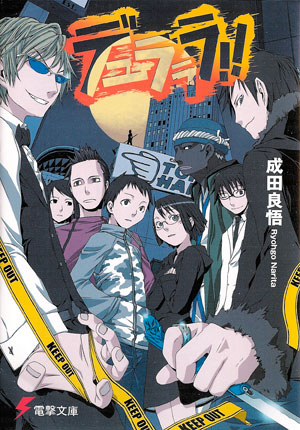
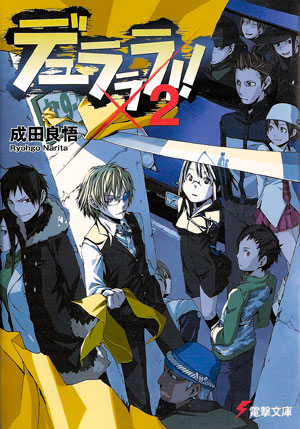
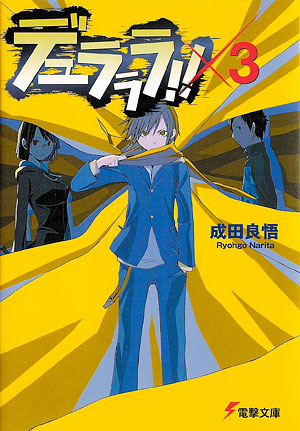
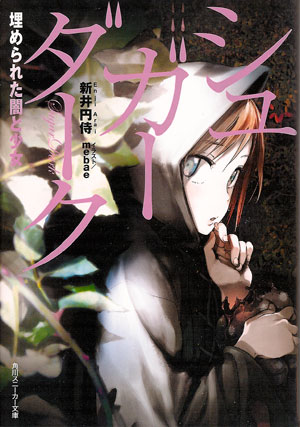

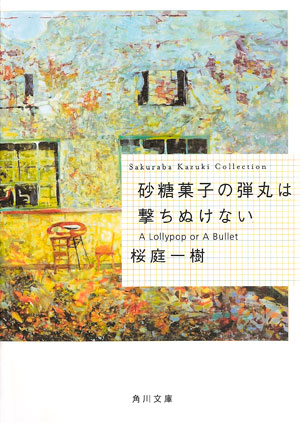
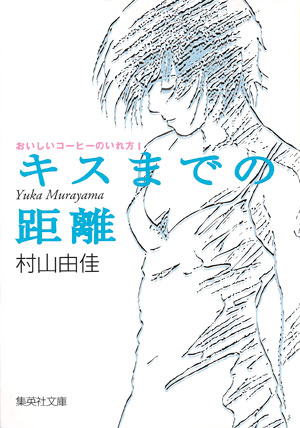
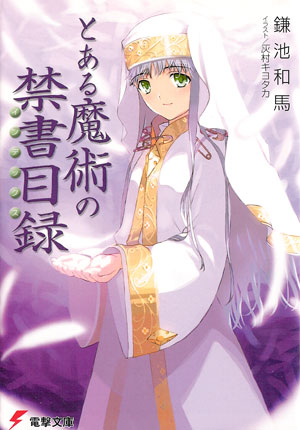
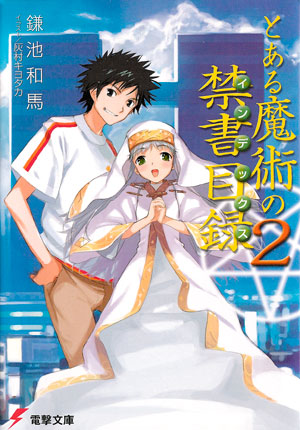
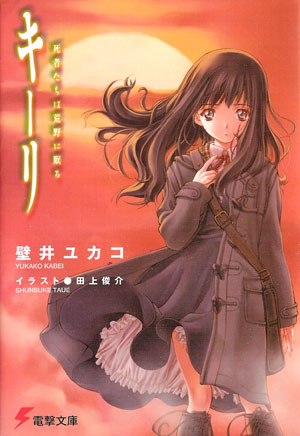
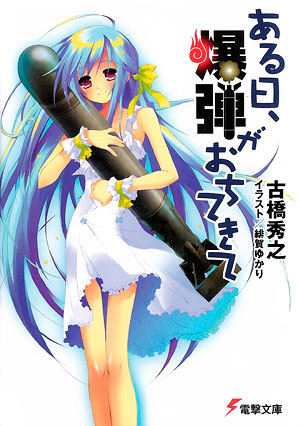 Title: Aru Hi, Bakudan ga Ochitekite
Title: Aru Hi, Bakudan ga Ochitekite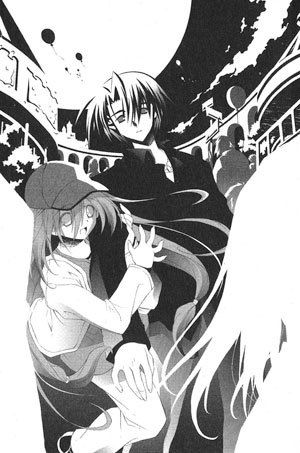 These seven tales aren’t all good, but there are true gems among them. My favourite was the second, where a high school boy is tasked with taking his childhood female friend home, since she’s caught the “idiot cold”. It’s a temporary infection that causes her memory to leap back a few years whenever she sneezes, effectively making her believe she’s younger, because she has no recollection of later events. Thus she moves closer and closer to infancy as the two walk homeward. While it may sound like a journey into pedophilia, it’s nothing like that. The beauty is in how this setting is used to gradually disclose details of the girl’s life, and the relationship between her and the narrating protagonist.
These seven tales aren’t all good, but there are true gems among them. My favourite was the second, where a high school boy is tasked with taking his childhood female friend home, since she’s caught the “idiot cold”. It’s a temporary infection that causes her memory to leap back a few years whenever she sneezes, effectively making her believe she’s younger, because she has no recollection of later events. Thus she moves closer and closer to infancy as the two walk homeward. While it may sound like a journey into pedophilia, it’s nothing like that. The beauty is in how this setting is used to gradually disclose details of the girl’s life, and the relationship between her and the narrating protagonist.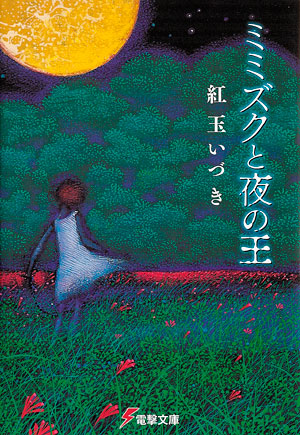 Title: Mimizuku to Yoru no Ou
Title: Mimizuku to Yoru no Ou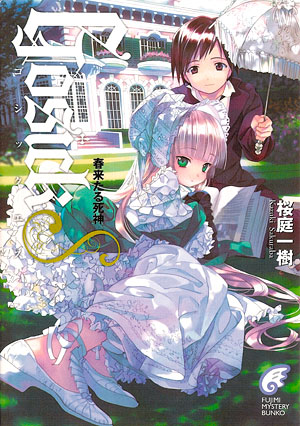 Title: GOSICKs - Haru Kitaru Shinigami
Title: GOSICKs - Haru Kitaru Shinigami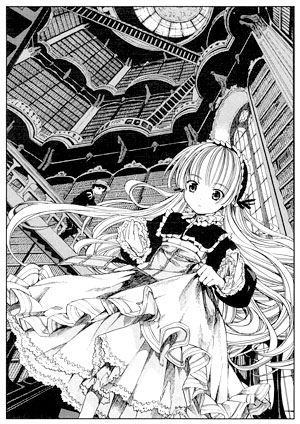 The genre appears to be mystery, but the reader is given no chance to puzzle these out for himself, and they’re not particularly engaging. Instead it’s the character interaction that keeps it interesting, with the overly serious Kazuya and infinitely stuck-up Victorica warming up to each other’s company. Victorica is a peculiar creature, described — in exactly the same way no less than five times over the course of this volume — as looking just like a doll, with blonde hair and exquisite features, which in combination with her attitude makes her hard to separate from Rozen Maiden’s Shinku, but I suppose their eye colours differ.
The genre appears to be mystery, but the reader is given no chance to puzzle these out for himself, and they’re not particularly engaging. Instead it’s the character interaction that keeps it interesting, with the overly serious Kazuya and infinitely stuck-up Victorica warming up to each other’s company. Victorica is a peculiar creature, described — in exactly the same way no less than five times over the course of this volume — as looking just like a doll, with blonde hair and exquisite features, which in combination with her attitude makes her hard to separate from Rozen Maiden’s Shinku, but I suppose their eye colours differ.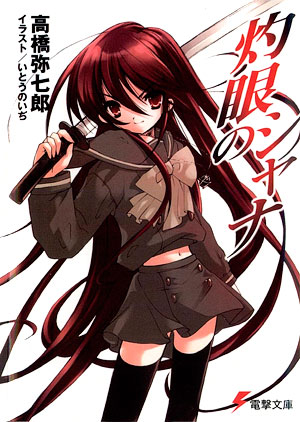 Title: Shakugan no Shana
Title: Shakugan no Shana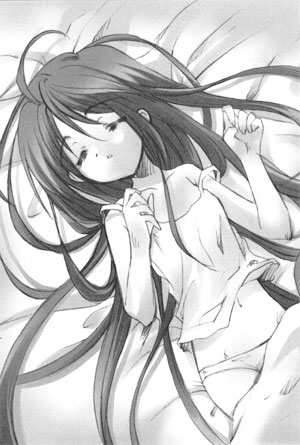 Right, setting aside the pedophilia, Takahashi has a terrible habit of stuffing commas into his sentences. I’m decently fond of commas, admittedly, because they can be used to create a nice reading rhythm, or clear up long and complex sentences. However, Takahashi seems to think they’re some sort of magic literature tool that transforms your prose into shiny diamonds. The result is an incredibly annoying experience of reading two words, pausing mentally, then reading two more, pausing, reading a bit, pausing, and then you finally reach a blessed period and can attempt to extract the commas and parse it as a proper sentence. I’m surprised his editor didn’t strangle him after the first chapter, because I definitely would have.
Right, setting aside the pedophilia, Takahashi has a terrible habit of stuffing commas into his sentences. I’m decently fond of commas, admittedly, because they can be used to create a nice reading rhythm, or clear up long and complex sentences. However, Takahashi seems to think they’re some sort of magic literature tool that transforms your prose into shiny diamonds. The result is an incredibly annoying experience of reading two words, pausing mentally, then reading two more, pausing, reading a bit, pausing, and then you finally reach a blessed period and can attempt to extract the commas and parse it as a proper sentence. I’m surprised his editor didn’t strangle him after the first chapter, because I definitely would have.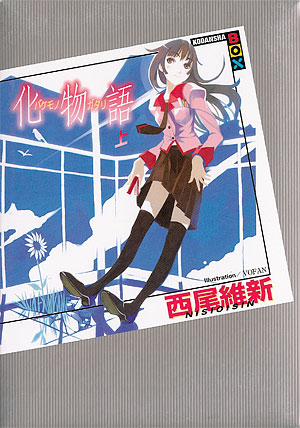 Title: Bakemonogatari 1
Title: Bakemonogatari 1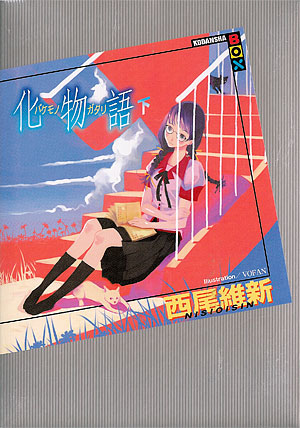 Every arc ends with an epilogue, where Koyomi explains the “twist” of the story. Much like Hollywood director
Every arc ends with an epilogue, where Koyomi explains the “twist” of the story. Much like Hollywood director 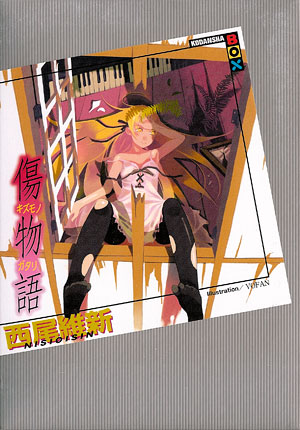 Title: Kizumonogatari
Title: Kizumonogatari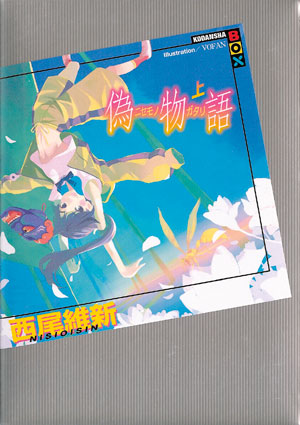
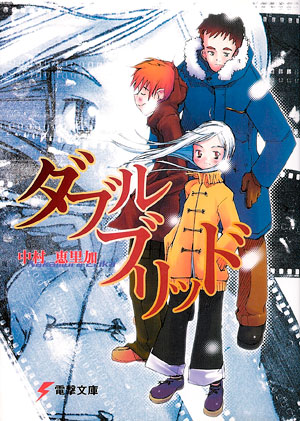 Title: Doublebrid
Title: Doublebrid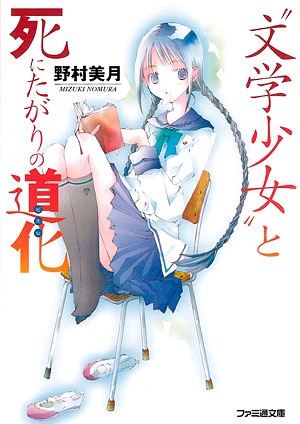 Title: “Bungaku Shoujo” to Shinitagari no Pierrot
Title: “Bungaku Shoujo” to Shinitagari no Pierrot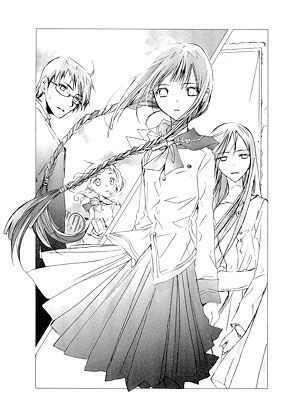 Unfortunately, the mystery isn’t handled very well. I’m an enormous fan of the genre, having read dozens of Poirot and Miss Marple novels by
Unfortunately, the mystery isn’t handled very well. I’m an enormous fan of the genre, having read dozens of Poirot and Miss Marple novels by 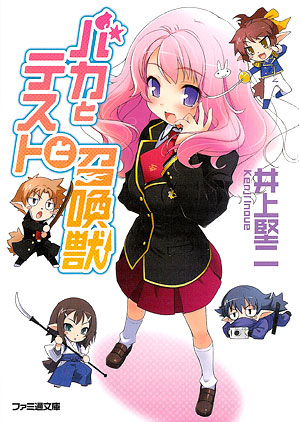 Title: Baka to Tesuto to Shoukanjuu
Title: Baka to Tesuto to Shoukanjuu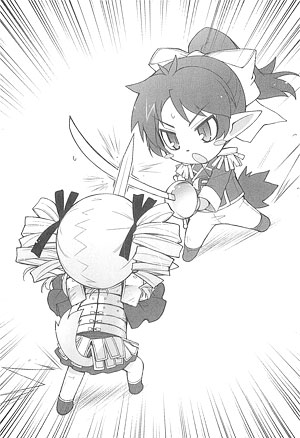 Summons? Is this a magical fantasy land? I’ve no idea, dear readers. It’s not entirely explained how these mystical creatures appear, only that a teacher has to be in the vicinity for the summon to work, and that a glowing circle shows up on the ground. Maybe there’s an advanced holographic physics manipulation device hidden in the school basement. It doesn’t really matter, because the plot is irrelevant. This series is all about the comedy, and as much as 90% of the text in the first novel is made up of dialogue. This makes BakaTest a swift read, and it may be a good starting point if you’re thinking of leveling up from manga reading. Up to half a page can be filled with RPG-like battle statistics, making the text even sparser.
Summons? Is this a magical fantasy land? I’ve no idea, dear readers. It’s not entirely explained how these mystical creatures appear, only that a teacher has to be in the vicinity for the summon to work, and that a glowing circle shows up on the ground. Maybe there’s an advanced holographic physics manipulation device hidden in the school basement. It doesn’t really matter, because the plot is irrelevant. This series is all about the comedy, and as much as 90% of the text in the first novel is made up of dialogue. This makes BakaTest a swift read, and it may be a good starting point if you’re thinking of leveling up from manga reading. Up to half a page can be filled with RPG-like battle statistics, making the text even sparser.
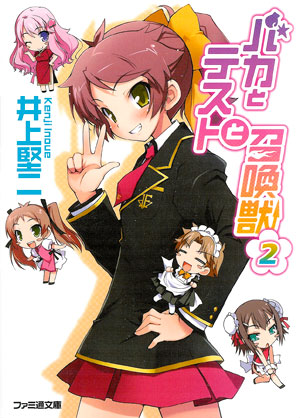
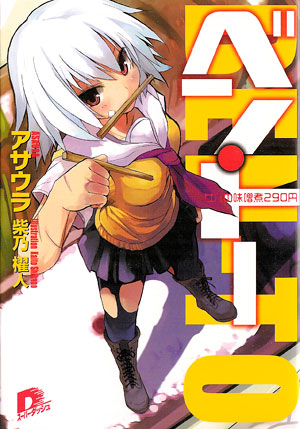 Title: Ben-to - Saba no Misoni 290 yen
Title: Ben-to - Saba no Misoni 290 yen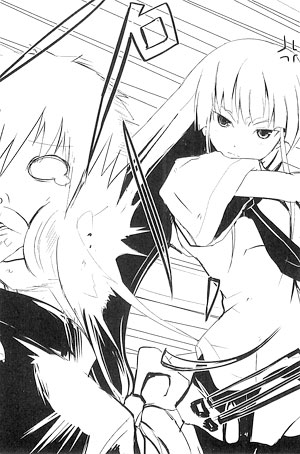 Another strong point of this title is the humour, which is quite dark and may not fit everyone. As if to explain to us just how much of a bastard Satou can be, there’s a short sequence relating how he moved his best friend’s clock back an hour in a feeble attempt to feel like he has some control over cruel, uncaring Time, which resulted in his friend coming an hour late for next morning’s final exams and as a consequence he failed to get into his preferred high school, which Satou doesn’t seem to feel the least guilty about. To counter this, the extremely abusive female classmate Shiraume Ume appears, who doesn’t like Satou messing with “her” Oshiroi, and to discourage it she frequently slaps the utter crap out of him (see illustration), all the while rigging the upcoming school president election in her favour. In addition to this control freak, poor Oshiroi has some additional quirks: she loves writing homoerotic fiction, and her reason for approaching the half-priced box lunch battles was to gather material for her stories, in which Satou happens to become a prominent character.
Another strong point of this title is the humour, which is quite dark and may not fit everyone. As if to explain to us just how much of a bastard Satou can be, there’s a short sequence relating how he moved his best friend’s clock back an hour in a feeble attempt to feel like he has some control over cruel, uncaring Time, which resulted in his friend coming an hour late for next morning’s final exams and as a consequence he failed to get into his preferred high school, which Satou doesn’t seem to feel the least guilty about. To counter this, the extremely abusive female classmate Shiraume Ume appears, who doesn’t like Satou messing with “her” Oshiroi, and to discourage it she frequently slaps the utter crap out of him (see illustration), all the while rigging the upcoming school president election in her favour. In addition to this control freak, poor Oshiroi has some additional quirks: she loves writing homoerotic fiction, and her reason for approaching the half-priced box lunch battles was to gather material for her stories, in which Satou happens to become a prominent character.
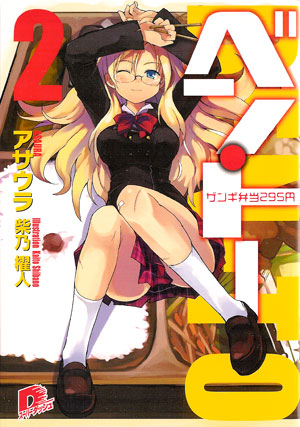
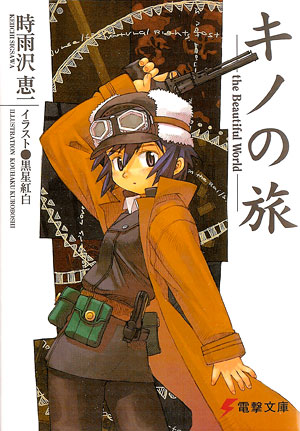 Title: Kino no Tabi - The Beautiful World
Title: Kino no Tabi - The Beautiful World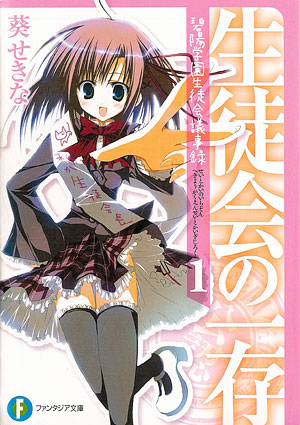 Title: Seitokai no Ichizon - Hekiyou Gakuen Seitokai Gijiroku 1
Title: Seitokai no Ichizon - Hekiyou Gakuen Seitokai Gijiroku 1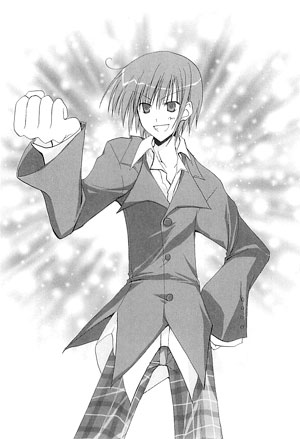 Excited yet? You shouldn’t be, because Seitokai no Ichizon is utter crap. I’ve racked my brain for a book I’ve read in my life that was less entertaining than this, and I came up blank. As previously noted, it’s primarily a comedy, and I require one small thing from comedies: laughter. This book failed to deliver every single time, line after line. It’s 270 pages of painfully lame jokes, where the author is pitifully trying to be funny, and all you can do is cringe at how insanely bad it is. Getting through an entire novel like this is a feat to be proud of, but there’s no reward at the end, just an empty feeling of having wasted hours on filling your mind with vacuum.
Excited yet? You shouldn’t be, because Seitokai no Ichizon is utter crap. I’ve racked my brain for a book I’ve read in my life that was less entertaining than this, and I came up blank. As previously noted, it’s primarily a comedy, and I require one small thing from comedies: laughter. This book failed to deliver every single time, line after line. It’s 270 pages of painfully lame jokes, where the author is pitifully trying to be funny, and all you can do is cringe at how insanely bad it is. Getting through an entire novel like this is a feat to be proud of, but there’s no reward at the end, just an empty feeling of having wasted hours on filling your mind with vacuum.